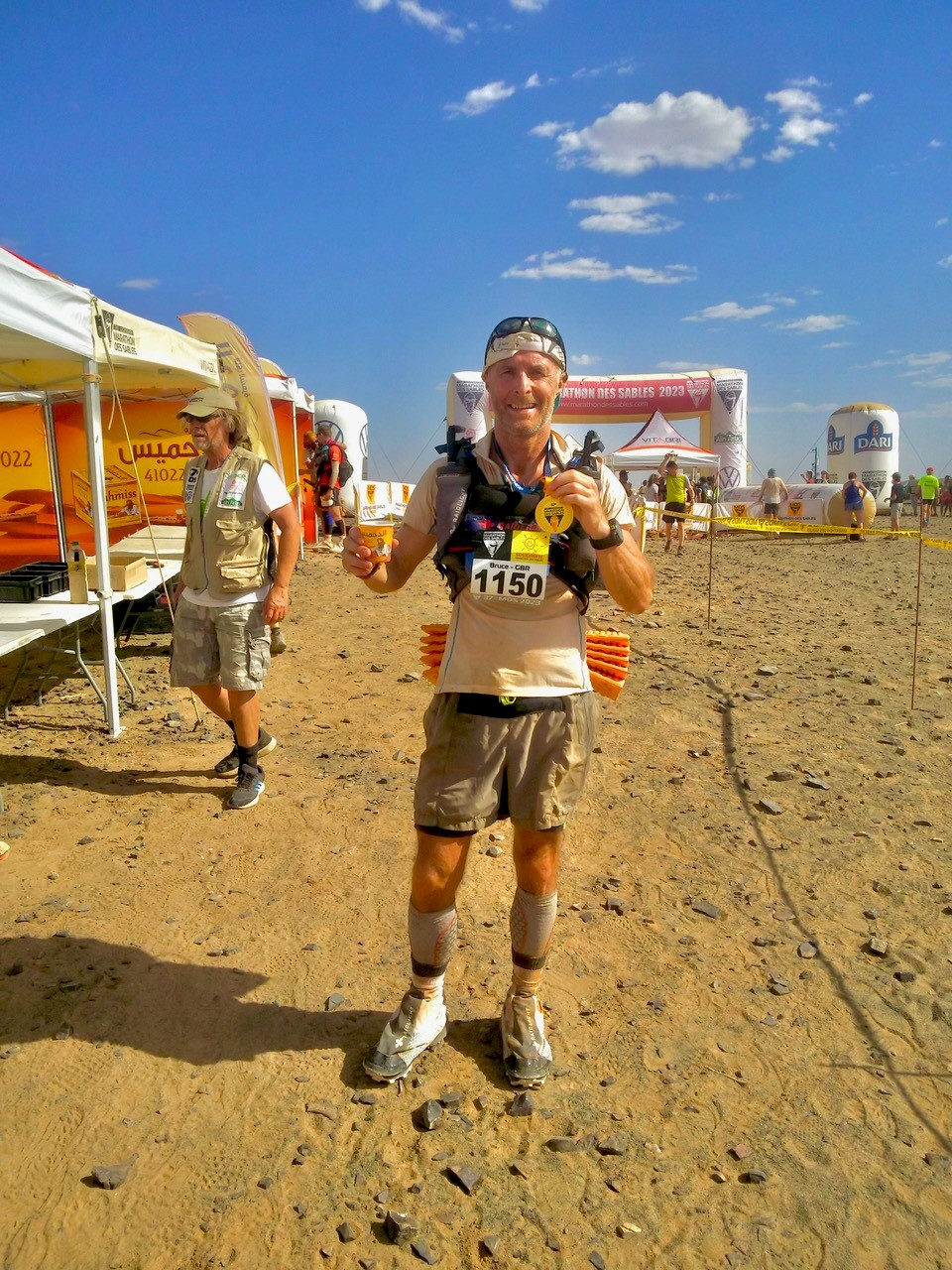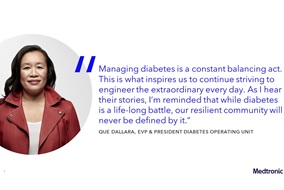People with type 1 diabetes can do anything, even an ultra-marathon
Bruce McLaren recently crossed the finish line in one of the most grueling endurance events in the world, the famous Marathon des Sables. And he did it all while wearing an insulin pump.
Bruce McLaren recently crossed the finish line in one of the most grueling endurance events in the world, the famous Marathon des Sables. And he did it all while wearing an insulin pump.
He ran 250 km (155 miles) over six days in the Moroccan desert, crossing sand dunes and herds of camels.
 Bruce McLaren with his medal after completing the famous Marathon de Sables in Morocco.
Bruce McLaren with his medal after completing the famous Marathon de Sables in Morocco.Bruce, originally from Edinburgh and now living in London, was diagnosed with type 1 diabetes at age 30. He uses the MiniMed™ 780G advanced hybrid closed-loop insulin pump system, which automatically adjusts insulin delivery all day and night to help prevent highs and lows.§
Bruce had to carry all his food for the entire week, so he had to make limited rations count.
“Conserving carbs, in particular ensuring I have enough carbs to treat hypoglycemia (when the sugar in blood falls below an individual’s healthy levels), was an important part of my strategy, and my No. 1 focus was avoiding hypoglycemia,” said Bruce. “Having access to data on the pump was invaluable and the graph showing clear trends made management much simpler.”
He has always enjoyed sports and never let his diabetes prevent his love of the outdoors or competing in races. If anything, it spurs him on. Managing diabetes while endurance-running adds an extra challenge, particularly when the race starts each day shortly after breakfast when there is still active insulin on board.
He especially appreciated the SmartGuardTM technology in the MiniMedTM 780G system, which uses glucose readings provided by a sensor and transmitter worn on his body to automatically adjust insulin delivery every five minutes as required. §
“Blood glucose levels are usually high on race day, fueled by adrenaline, so it’s brilliant to wake up every day with levels within a healthy range so that you start off on the right foot,” he said.
It had been a long wait for the ultra-marathon. Bruce signed up for the event during the pandemic, but an injury prevented him from competing in 2022.
So, Bruce found himself getting emotional as he crossed the finish line.
“It was an amazing experience; the desert is a special place. It is remote, it is stunning, and survival is hard there,” he said. “I was humbled to experience it and proud to show that people with type 1 diabetes can do anything.”
Learn more about Medtronic Diabetes.
1. Thoughts and opinions are his own. Individual results vary.
§ Refers to SmartGuard™ feature. Individual results may vary.
IMPORTANT SAFETY INFORMATION:
MINIMED™780G SYSTEM WITH SMARTGUARD™ TECHNOLOGY WITH GUARDIAN™ 4 SENSOR
The MiniMed™ 780G system is intended for continuous delivery of basal insulin at selectable rates, and the administration of insulin boluses at selectable amounts for the management of type 1 diabetes mellitus in persons seven years of age and older requiring insulin as well as for the continuous monitoring and trending of glucose levels in the fluid under the skin. The MiniMed™ 780G system includes SmartGuard™ technology, which can be programmed to automatically adjust insulin delivery based on the continuous glucose monitoring (CGM) sensor glucose values and can suspend delivery of insulin when the sensor glucose (SG) value falls below or is predicted to fall below predefined threshold values.
The Medtronic MiniMed™ 780G system consists of the following devices: MiniMed™ 780G insulin pump, the Guardian™ 4 transmitter, the Guardian™ 4 sensor, One-press serter, the Accu-Chek™ Guide Link blood glucose meter, and the Accu-Chek™ Guide test strips. The system requires a prescription from a healthcare professional.
The Guardian™ 4 sensor is intended for use with the MiniMed™ 780G system and the Guardian 4 transmitter to monitor glucose levels for the management of diabetes. The sensor is intended for single use and requires a prescription. The Guardian™ 4 sensor is indicated for up to seven days of continuous use.
The Guardian™ 4 sensor is not intended to be used directly to make therapy adjustments while the MiniMed™ 780G is operating in manual mode. All therapy adjustments in manual mode should be based on measurements obtained using a blood glucose meter and not on values provided by the Guardian™ 4 sensor. The Guardian™ 4 sensor has been studied and is approved for use in patients ages 7 years and older and in the arm insertion site only. Do not use the Guardian™ 4 sensor in the abdomen or other body sites including the buttocks, due to unknown or different performance that could result in hypoglycemia or hyperglycemia.
WARNING: Do not use the SmartGuard™ feature for people who require less than 8 units or more than 250 units of total daily insulin per day. A total daily dose of at least 8 units, but no more than 250 units, is required to operate in the SmartGuard™ feature.
WARNING: Do not use the MiniMed™ 780G system until appropriate training has been received from a healthcare professional. Training is essential to ensure the safe use of the MiniMed™ 780G system.
WARNING: Do not use SG values to make treatment decisions, including delivering a bolus, while the pump is in Manual Mode. When the SmartGuard™ feature is active and you are no longer in Manual Mode, the pump uses an SG value, when available, to calculate a bolus amount. However, if your symptoms do not match the SG value, use a BG meter to confirm the SG value. Failure to confirm glucose levels when your symptoms do not match the SG value can result in the infusion of too much or too little insulin, which may cause hypoglycemia or hyperglycemia.
Pump therapy is not recommended for people whose vision or hearing does not allow for the recognition of pump signals, alerts, or alarms. The safety of the MiniMed™ 780G system has not been studied in pregnant women, persons with type 2 diabetes, or in persons using other anti-hyperglycemic therapies that do not include insulin. For complete details of the system, including product and important safety information such as indications, contraindications, warnings and precautions associated with system and its components, please consult https://www.medtronicdiabetes.com/important-safety-information#minimed-780g and the appropriate user guide at https://www.medtronicdiabetes.com/download-library.
L001-10152023
Related content



